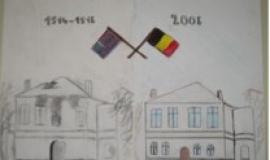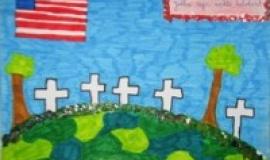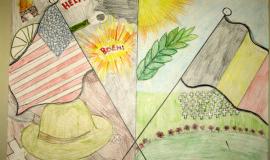In 2008, AOMDA implemented the Art & Remembrance Contest for the first time in Waregem, Belgium. We specfiied the following :
Contest Objectives:
- To help today’s young people understand the meaning of Memorial Day and gain an appreciation for the sacrifice paid by the soldiers interred in Flanders Field American Cemetery, who died in the liberation of Europe during World War I;
- To invite people of all ages to enjoy the children’s artworks and to appreciate this visual reminder of why historical events continue to have relevance for our world today.
Competition Theme: “Why Should We Remember Them?”
Eligibility: For children aged 8 to 10 years old or enrolled in the 4th, 5th and 6th grades.
Artwork Competition Guidelines:
- Each student was invited to create a drawing, painting, sketch or collage that answered the question: “Why Should We Remember Them?”;
- Each artwork was to be captioned with an answer to this question. The caption could be worked into the design or included on the back of the design;
- Artworks were to be submitted on paper no larger than A4 format;
- Each artwork was to be clearly marked on the back with a unique identification number that the shool assigned to ensure the annonimity of the student.
Support Materials for Teachers:
For our pilot program, teachers were encouraged to develop any other possible means of integrating the art competition into their other courses. For example, we recommended that, in a history class, one could discuss with the students how the experience of war can or should be captured in art.
Selection of semi-finalists:
Since several hundred students were participating in the project, we asked each classroom teacher to select the TOP THREE artworks in any way they saw fit and to submit them no later than a given deadline to the contest coordinator. Semi-finalists’ artworks were to be grouped per school and delivered as one package per school. Over 150 drawings were received from the participating schools.
Evaluation Panel
The Evaluation Panel consisted of:
- A serving member of the armed forces
- A representative of the Flanders Field American Cemetery
- A representative of the United States Embassy to th Kingdom of Belium
- A representative of the AOMDA Foundation
- A university professor
Recognition and Awards for Winners:
All participating students received a special token of appreciation to recognize their efforts and participation.
A 1st, 2nd and 3rd place winner was selected. Each of these three winners and their families were invited to attend the annual Memorial Day ceremony in Waregem, where the winners were photographed senior officials, including the United States Ambassador to the Kingdom of Belgium and the Belgian Prime Minister. The three winning artworks were displayed at the Flanders Field American Cemetery visitors center. All of the artwork of the semi-finalists was displayed at the Waregem City Hall for several weeks following the ceremony. The winning artworks were also displayed online on AOMDA Belgium's website.
Success Factors:
The pilot project was particularly successful because it was fully integrated into the grade school curriculum in three schools in Waregem. To accomplish that objective, AOMDA Belgium brought together:
- The City of Waregem (Mayor’s Office)
- The Waregem City Archives (Historian)
- The teachers and principals of three grade schools
- The Flanders Field American Cemetery staff
- Representatives of the US military
- AOMDA Belgium community representatives
- Local press
Results and Evaluation:
The response was overwhelmingly positive:
- All teachers expressed an interest in repeating the program.
- All teachers also unanimously agreed that the contest provided a valuable and interactive means of teaching the material.
- All teachers said the contest provided a cross-departmental means of teaching the material (art class, music class, history, field trips, ethics...
- All teachers said the program influenced the way their students perceived Flanders Field American Cemetery and the World War.
A few teacher comments:
- “We were humbled by the question: ‘Why Should We Remember Them?”
- “Our students have long sung the American national anthem at the annual Memorial Day ceremony. Now they know why. Many were awestruck.”
- “The students were able, in a creative manner, to bring a historical aspect of our community life to the fore.”
- “By finding their own collage or slogan they could express what impression these many victims of the First World War have left on them.”
- “Our students are interested in the subject and never want another war to take place. The students were certainly influenced by this material and believe that the American soldiers buried in Waregem must never be forgotten. We shall never forget.”







